A Changing Landscape
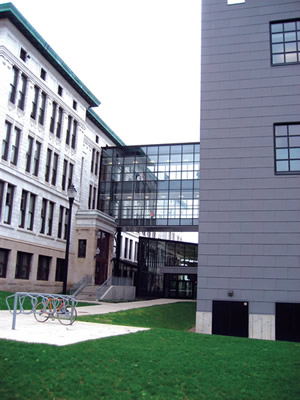
PHOTOS BY SCOTT BERMAN
Exterior spaces of schools have many sides. That is, they involve aspects of landscaping, security measures, fencing, outdoor furniture and furnishings, bollards and more.
School Planning & Management has visited the sites of a number of telling examples in recent months and years — examples that show creative and pragmatic uses of building exteriors and their surroundings.
And exteriors start with the building itself: its facade, which also serves to present a school, at least in a physical sense, to the community and wider world. But that’s just part of it: Consider how recently renovated or constructed buildings feature sophisticated facades as part of envelopes targeting energy efficiency by working in conjunction with advanced building systems. Some examples include:
- Lake Central High School in Indiana, where a large expansion and renovation project has remade the school inside and out. In one of many steps, officials explored the possibility of keeping intact a large section of brick façade in good condition, but tinting it to match the color of adjoining, newly constructed façade.
- Chester Redshaw Elementary in New Jersey and Henderson-Hopkins School in East Baltimore, Md., two newly constructed buildings scaled to the surrounding streetscape and with facades of varying color and form, heightening their exteriors’ visual interest.
- City Honors School in Buffalo, N.Y., and Cleveland Heights High School in Ohio, two older buildings that even with dramatic, comprehensive renovations and expansions retain their exterior character. At City Honors, there is a two-story glass sky bridge connecting a grand original building to a sleek addition; and Cleveland Heights, a project underway at this writing, is remaking itself inside and out while preserving its iconic clock tower, which oversees an eclectic neighborhood.
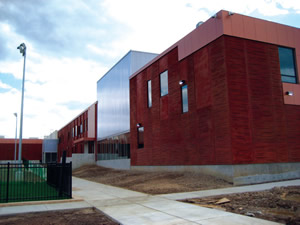
PHOTOS BY SCOTT BERMAN
Moving away from a building itself, other recent projects are making the very most of their immediate surroundings; in a sense, extending what a school is all about to the outdoors, even in urban settings.
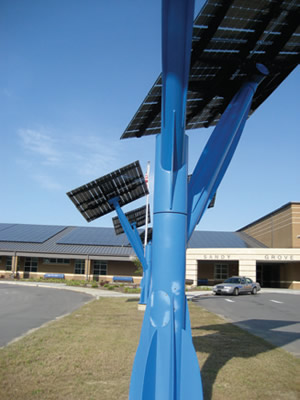
PHOTOS BY SCOTT BERMAN
In one example, a 17,000-square-foot outdoor space, called a Student Sanctuary, provides a distinctive setting for Union City High School in New Jersey. Designed by Becica Associates and opened in 2013, it’s a urban garden with a wide variety of plantings, subtle metal benches, stone paths trimmed with brick, and a semicircle pergola atop posts with low, attractive stone bases. The bases are joined by a semicircle of metal benches, with the ensemble sitting on a bluestone patio. Beside the pergola is a small amphitheatre in the form of a curved, flowing two-tier concrete bench — a spot that may be used for school performances. The designer’s website points out that the space’s landscaping is barrier free, as with a tiny bridge over a water element leading to the pergola.
In another aspect: the setting has security measures. First, there is a formidable perimeter fence, which features narrow pickets capped by a horizontal rail, all in dark metal. The pickets form a see-through barrier — thus balancing the high barrier with a sense of openness — and run between stout brick posts with thin masonry caps.
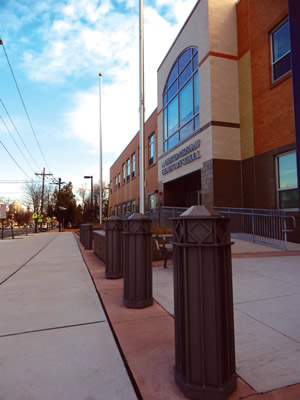
PHOTOS BY SCOTT BERMAN
And second, also as described on Becica Associates’ website, the outdoor area has “a security system with cameras and emergency bluelight stations and audio system with speakers connected to the school’s security and IT departments.” The system indicates the approach of using fencing not an example of how elements can converge to create attractive, secure spaces that extend a school building’s educational settings, indeed its identity, from the inside out.
A related dynamic is at found at Sandy Grove Middle School in North Carolina, where there is an impressive line of large solar panel towers leading to the school’s main entrance. The operating towers, one of the building’s systems that together generate 33 percent more energy than the school uses, proclaim the net-positive capability of the school in an eye-catching way.
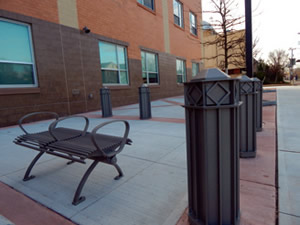
PHOTOS BY SCOTT BERMAN
It’s related to an important change for school grounds over the years: their increasing uses as environmentally, and educationally, beneficial approaches. The aforementioned Union City High has looked into the possibility of conducting environmental science classes there, according to a local news report, for example. Also, a look at the K-12 roster of the U.S. Department of Education’s Green Ribbon Schools across the United States shows gardening and storm water runoff components, for example, on the campuses of various honorees. It follows that an outdoor feature, bike racks that are conspicuous, secure and plentiful, along with safe bike routes, help provide an environmentally friendly and healthful commuting option for youngsters.
Exterior spaces can also be defined, and a school’s identity extended, in other ways: as in areas along public sidewalks. Take the aforementioned A. Chester Redshaw Elementary for example. There, a section of sidewalk abutting the building’s exterior near the school’s main entrance is outlined with a set of stout bollards and a matching bench under an exterior light, forming a convenient waiting area.
In another instance, Kirkwood High School in Missouri has an exterior plaza, called Pioneer Circle, with colorful sculpture at its center and ringed by long, curved steel benches by Victor Stanley — an ensemble forming an attractive place to pause. Keystone Ridge Designs, meanwhile, describes pragmatic factors to bear in mind for site furniture, including making choices based on a standard, organized approach.
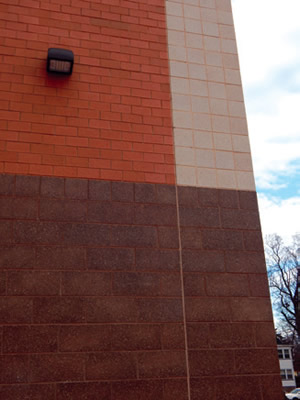
PHOTOS BY SCOTT BERMAN
Keystone’s Angela Maloney, director of marketing, believes that consistency in outdoor furnishings such as litter receptacles, bike racks, table sets, benches and recycling containers, is a key point. “Consistent colors, materials and product designs across campus contribute to a cohesive campus design and help to distinguish campus property.” There are a lot of aspects and spaces to consider, such as keying outdoor furniture with playground components and sizing benches and table sets, as needed, for youngsters. And such clarity can emanate out to encompass much more. As she explains, “in addition to maintaining consistency across an individual campus, school districts can strive to match products across the various schools within their district.”
Thus, exteriors can incorporate many elements while marshalling good design, even if on a limited footprint, to create attractive, useful exteriors and outdoor places. It’s all another way to help achieve, amplify, symbolize and reinforce educational goals while putting your best face forward.
Nature Deficit Disorder
“Last Child in the Woods, Saving our Children from Nature Deficit Disorder,” by child advocacy expert Richard Louv, highlights outdoor education, bringing together research indicating that direct exposure to nature is essential for healthy childhood development and for physical and emotional health. It includes 100 actions to create change in your school and community, 35 points to inspire discussion about the importance of nature in our lives and more.
This article originally appeared in the issue of .